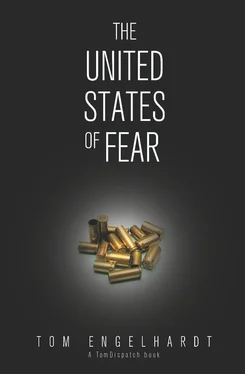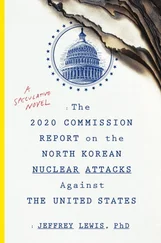And there is more—possibly much more—to come. In late June 2011, the Obama administration posted that unclassified summary of its 2011 National Strategy for Counterterrorism at the White House website. It’s a document that carefully avoids using the term war on terror , even though counterterrorism adviser Brennan did admit that it “tracked closely with the goals” of the Bush administration.
The document tries to argue that, when it comes to counterterrorism (or CT), the Obama administration has actually pulled back somewhat from the expansiveness of Bush-era GWOT thinking. We are now, it insists, only going after “al-Qaeda and its affiliates and adherents,” not every “terror group” on the planet. But here’s the curious thing: when you check out its “areas of focus,” other than “the Homeland” (always capitalized as if our country were the United States of Homeland), what you find is an expanded version of the Bush global target zone, including the Maghreb and Sahel (North Africa), East Africa, the Arabian Peninsula, Iraq, South Asia, Central Asia, and—thrown in for good measure—Southeast Asia. In most of those areas, Bush-style hunting season is evidently still open.
If you consider deeds, not words, when it comes to drones the arc of instability is expanding—and based on the new counterterrorism document, the next place for our robotic assassins to cross borders in search of targets could be the Maghreb and Sahel. There, we’re told, al-Qaeda in the Lands of the Islamic Maghreb (AQIM), with roots in Algeria but operatives in northern Mali, among other places, potentially threatens “U.S. citizens and interests in the region.”
Here’s how the document puts the matter in its classically bureaucratese version of English: “[W]e must therefore pursue near-term efforts and at times more targeted approaches that directly counter AQIM and its enabling elements. We must work actively to contain, disrupt, degrade, and dismantle AQIM as logical steps on the path to defeating the group. As appropriate, the United States will use its CT tools, weighing the costs and benefits of its approach in the context of regional dynamics and perceptions and the actions and capabilities of its partners in the region.”
That may not sound so ominous, but best guess: the GWOT is soon likely to be on the march across North Africa, heading south. And Obama national security appointments only emphasize how much the drone wars are on Washington’s future agenda. After all, Leon Panetta, the man who since 2009 ran the CIA’s drone wars, has moved over to the Pentagon as secretary of defense, while Bush’s favorite general, David Petraeus, the war commander who loosed American air power (including drone power) in a massive way in Afghanistan, is moving on to the CIA.
On his first visit to South Asia as secretary of defense, Panetta made the claim that Washington was “within reach of strategically defeating al-Qaeda.” Perhaps it won’t surprise you that such news signals not a winding down, but a ratcheting up, of the Global War on Terror. Panetta, as Craig Whitlock of the Washington Post reported, “hinted of more to come, saying he would redouble efforts by the military and the spy agency to work together on counterterrorism missions outside the traditional war zones of Afghanistan and Iraq.”
More to come, as two men switching their “civilian” and military roles partner up. Count on drone-factory assembly lines to rev up as well, and the military’s special operations forces to be in expansion mode. And note that by the penultimate page of that CT strategy summary, the administration has left al-Qaeda behind and is muttering in bureau-speak about Hezbollah and Hamas, Iran and Syria (“active sponsors of terrorism”), and even the Revolutionary Armed Forces of Colombia.
On the Bush administration’s watch, the United States blew a gasket, American power went into decline, and the everyday security of everyday Americans took a major hit. Still, give them credit. They were successful on at least one count: they made sure that we’d never stop fighting their war on terror. In this sense, Obama and his top officials are a drone national security team, carrying out the dreams and fantasies of their predecessors, while Bush and his men (and woman) give lucrative speeches and write books hundreds or thousands of miles away.
Chapter 2
ENTERING THE SOVIET ERA
Mark it on your calendar. It seems we’ve finally entered the Soviet era in America.
You remember the Soviet Union, now almost twenty years in its grave, but who gives it a second thought today? Even in its glory years, that “evil empire” was sometimes referred to as “the second superpower.” In 1991, after seven decades, it suddenly disintegrated and disappeared, leaving the United States—the “sole superpower” or even the “hyperpower,” on planet Earth—surprised but triumphant.
The USSR had been heading for the exits for quite a while, not that official Washington had a clue. At the moment it happened, Soviet “experts” like Robert Gates, then director of the CIA, still expected the Cold War to go on and on. In Washington, eyes were trained on the might of the Soviet military, which the Soviet leadership had never stopped feeding, even as its sclerotic bureaucracy was rotting, its economy (which had ceased to grow in the late 1970s) was tanking, budget deficits were soaring, indebtedness to other countries was growing, and social welfare payments were eating into what funds remained. Not even a vigorous reformist leader like Mikhail Gorbachev could stanch the rot, especially when, in the late 1980s, the price of Russian oil fell drastically.
Looking back, the most distinctive feature of the last years of the Soviet Union may have been the way it continued to pour money into its military—and its military adventure in Afghanistan—when it was already going bankrupt and the society it had built was beginning to collapse around it. In the end, its aging leaders made a devastating miscalculation. They mistook military power for power on this planet. Armed to the teeth and possessing a nuclear force capable of destroying the Earth many times over, the Soviets nonetheless remained the vastly poorer, weaker, and (except when it came to the arms race) far less technologically innovative of the two superpowers.
In December 1979, perhaps taking the bait of the Carter administration, whose national security adviser was eager to see the Soviets bloodied by a “Vietnam” of their own, the Red Army invaded Afghanistan to support a weak Communist government in Kabul. When resistance in the countryside, led by Islamic fundamentalist guerrillas and backed by the other superpower, only grew, the Soviets sent in more troops, launched major offensives, called in air power, and fought on brutally and futilely for a decade until, in 1989, long after they had been whipped, they withdrew in defeat.
Gorbachev had dubbed Afghanistan “the bleeding wound,” and when the wounded Red Army finally limped home, it was to a country that would soon cease to exist. For the Soviet Union, Afghanistan had literally proven “the graveyard of empires.” If, at the end, its military remained standing, the empire didn’t.
If you don’t already find this description just a tad eerie, given the present moment in the United States, you should.
In Washington, the Bush administration—G. H. W.’s, not G. W.’s—declared victory and then left the much ballyhooed “peace dividend” in the nearest ditch. Caught off guard by the collapse of the Soviet Union, Washington’s consensus policy makers drew no meaningful lessons from it, just as they had drawn few that mattered from their Vietnam defeat sixteen years earlier.
Читать дальше












